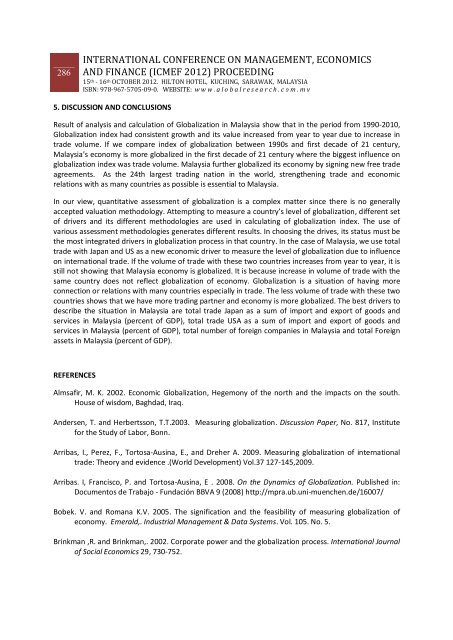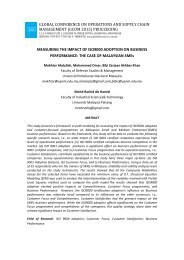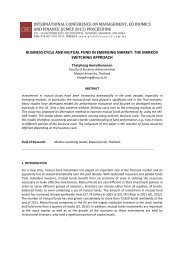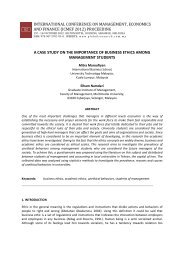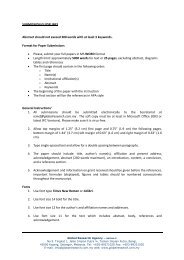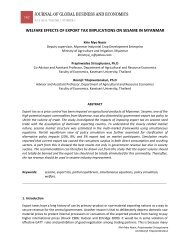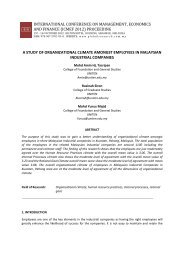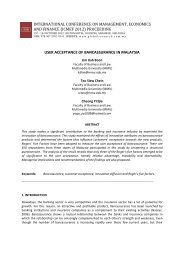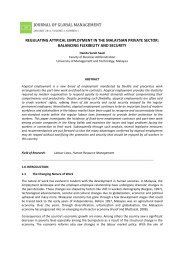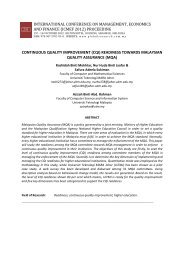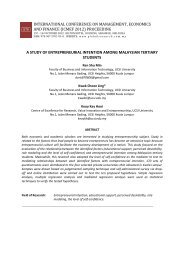(icmef 2012) proceeding developing standardized economic drivers f
(icmef 2012) proceeding developing standardized economic drivers f
(icmef 2012) proceeding developing standardized economic drivers f
You also want an ePaper? Increase the reach of your titles
YUMPU automatically turns print PDFs into web optimized ePapers that Google loves.
286<br />
INTERNATIONAL CONFERENCE ON MANAGEMENT, ECONOMICS<br />
AND FINANCE (ICMEF <strong>2012</strong>) PROCEEDING<br />
15 th - 16 th OCTOBER <strong>2012</strong>. HILTON HOTEL, KUCHING, SARAWAK, MALAYSIA<br />
ISBN: 978-967-5705-09-0. WEBSITE: w w w . g l o b a l r e s e a r c h . c o m . m y<br />
5. DISCUSSION AND CONCLUSIONS<br />
Result of analysis and calculation of Globalization in Malaysia show that in the period from 1990-2010,<br />
Globalization index had consistent growth and its value increased from year to year due to increase in<br />
trade volume. If we compare index of globalization between 1990s and first decade of 21 century,<br />
Malaysia’s economy is more globalized in the first decade of 21 century where the biggest influence on<br />
globalization index was trade volume. Malaysia further globalized its economy by signing new free trade<br />
agreements. As the 24th largest trading nation in the world, strengthening trade and <strong>economic</strong><br />
relations with as many countries as possible is essential to Malaysia.<br />
In our view, quantitative assessment of globalization is a complex matter since there is no generally<br />
accepted valuation methodology. Attempting to measure a country’s level of globalization, different set<br />
of <strong>drivers</strong> and its different methodologies are used in calculating of globalization index. The use of<br />
various assessment methodologies generates different results. In choosing the drives, its status must be<br />
the most integrated <strong>drivers</strong> in globalization process in that country. In the case of Malaysia, we use total<br />
trade with Japan and US as a new <strong>economic</strong> driver to measure the level of globalization due to influence<br />
on international trade. If the volume of trade with these two countries increases from year to year, it is<br />
still not showing that Malaysia economy is globalized. It is because increase in volume of trade with the<br />
same country does not reflect globalization of economy. Globalization is a situation of having more<br />
connection or relations with many countries especially in trade. The less volume of trade with these two<br />
countries shows that we have more trading partner and economy is more globalized. The best <strong>drivers</strong> to<br />
describe the situation in Malaysia are total trade Japan as a sum of import and export of goods and<br />
services in Malaysia (percent of GDP), total trade USA as a sum of import and export of goods and<br />
services in Malaysia (percent of GDP), total number of foreign companies in Malaysia and total Foreign<br />
assets in Malaysia (percent of GDP).<br />
REFERENCES<br />
Almsafir, M. K. 2002. Economic Globalization, Hegemony of the north and the impacts on the south.<br />
House of wisdom, Baghdad, Iraq.<br />
Andersen, T. and Herbertsson, T.T.2003. Measuring globalization. Discussion Paper, No. 817, Institute<br />
for the Study of Labor, Bonn.<br />
Arribas, I., Perez, F., Tortosa-Ausina, E., and Dreher A. 2009. Measuring globalization of international<br />
trade: Theory and evidence .(World Development) Vol.37 127-145,2009.<br />
Arribas. I, Francisco, P. and Tortosa-Ausina, E . 2008. On the Dynamics of Globalization. Published in:<br />
Documentos de Trabajo - Fundación BBVA 9 (2008) http://mpra.ub.uni-muenchen.de/16007/<br />
Bobek. V. and Romana K.V. 2005. The signification and the feasibility of measuring globalization of<br />
economy. Emerald,. Industrial Management & Data Systems. Vol. 105. No. 5.<br />
Brinkman ,R. and Brinkman,. 2002. Corporate power and the globalization process. International Journal<br />
of Social Economics 29, 730-752.


